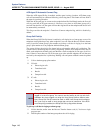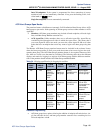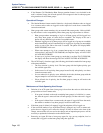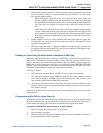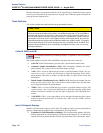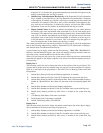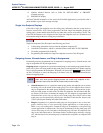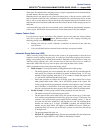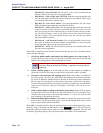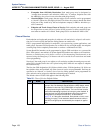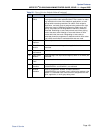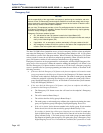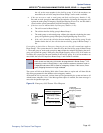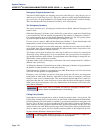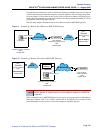
System Features
INTER-TEL
®
CS-5200/5400 ADMINISTRATOR GUIDE, ISSUE 1.1 – August 2005
Page 156 Automatic Route Selection (ARS)
— Dial Rule #2 – Echo Toll Field: The toll field (1, 0, 01, or 011) is included in the
number, if dialed. This dial rule is non-programmable.
— Dial Rule #3 – Echo 3 Digits After Toll Field: With this non-programmable dial
rule, the three digits after the toll field are included in the number. (These digits
are usually the area code or country code.)
— Dial Rule #4 – Echo Local Address: This non-programmable dial rule allows
ARS to dial the phone number that was dialed by the user.
— Dial Rule #5 – Add Account Code: This non-programmable dial rule causes the
system to dial the account code that is associated with the call, when it is avail-
able. The account code can be entered using any of the account code types, includ-
ing All Calls Following, as long as the system receives the account code before
the end of dialing. (To use an optional account code, the code must be entered
before the number is dialed.)
— Dial Rule #6 – Add Extension Number: This non-programmable dial rule tells
the system to include the extension number of the endpoint or voice processing
system application that is being used to place the call.
— Dial Rule #7 – Add #: This dial rule adds a pound (#) to the number dialed. This
dial rule can be programmed.
When ARS is selected, the user dials the number (including the area code, if needed), and the
system does the following:
1. Checks the dialed number and matches the dialing pattern to a route group: The
system checks the route groups in numerical order and selects the first group that
applies to the dialing pattern of the number that was dialed.
2. Selects a facility group: If all of the trunks are busy, and the endpoint is enabled for
ARS camp on, the call will camp on to the facility group until a trunk is available.
3. Checks for toll restrictions and outgoing access: Before the number is modified by
the facility group’s dial rules, the system checks the endpoint toll restrictions and outgo-
ing access to determine whether the call is allowed. If allowed, the system continues to
the next step. If not allowed, the system sends reorder tones, and the call is not placed.
All calls placed using ARS are toll restricted, regardless of whether the selected trunk is
subject to toll restriction. However, Emergency Call feature calls are never toll-
restricted.
4. Adds or deletes digits according to the facility group chosen: Each facility group has
a programmed set of dial rules that tells the system what to dial. For example, if the
selected route group requires that the number contain “1” but no area code, the dial
rules include the 1 and drop the area code.
5. Dials the modified phone number: If the number is allowed, the system seizes an idle
trunk in one of the selected trunk groups, waits for the Dialing Wait After Connect
timer to expire, and then dials the number.
When ARS is used, the user hears dial tone when the feature code is entered (manually or auto-
matically using a Call button, the ARS button, or the button). The user then dials
the number and hears silence until the trunk is seized and dialing is completed. (The user will
not hear the digits being dialed.) The call appears under an available Call or trunk button.
NOTE
If the Emergency Call feature is programmed to use ARS, the emergency
calls will always go through Route Group 1, regardless of route group pro-
gramming.
OUTGOING



